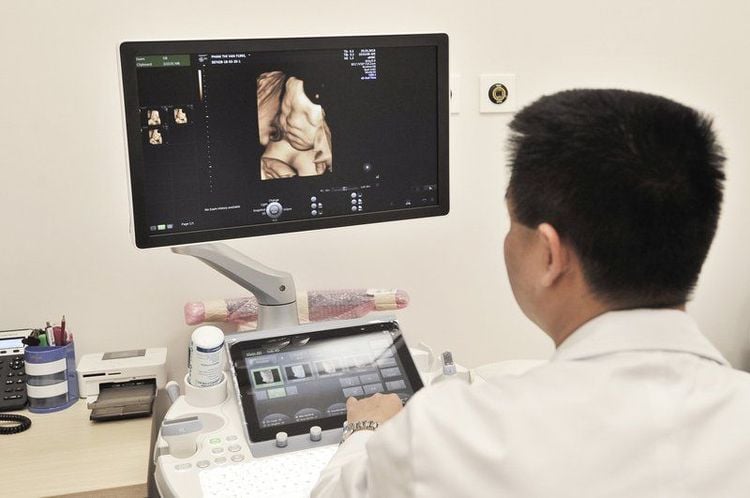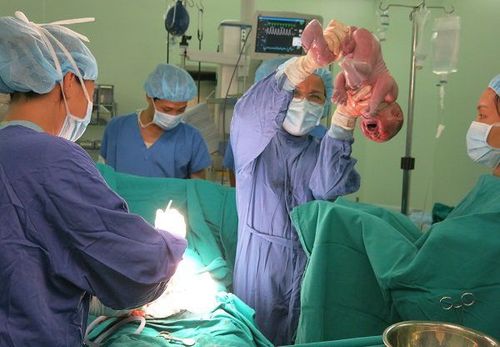This is an automatically translated article.
When a woman has a normal pregnancy, if the pregnancy is long enough, labor and delivery is a natural thing. However, during labor, there are a number of problems that can arise that affect both mother and baby. In order to have the necessary understanding, pregnant women and their relatives should be equipped with sufficient knowledge about labor to work with medical staff to help ensure a safe delivery.1. Signs of labor
Abdominal pain intermittently due to increasing contractions of the uterus, the frequency of uterine contractions usually reaches 3 episodes in 10 minutes, each lasts more than 20 seconds. Pregnant women see bloody mucus in the vagina Amniotic fluid break: See clear or colored fluid flowing out through the vagina. Examination revealed: the cervix is completely or completely erased and has dilated from 2cm or more; Formation of the amniotic sac. As soon as she sees signs of labor, pregnant women should go to medical facilities to be monitored and fully cared for during labor until after the baby is born.
2. What do normal labor need to monitor?
When labor occurs, at the obstetrician's health facility, the following signs are closely monitored:
2.1 Monitor the overall condition of the pulse During labor, the pulse is taken every 4 hours. Normally, the pulse is 70-80 times/minute, the pulse is fast 100 times/minute or slow 60 times/minute is an abnormal sign, if you are at the commune level, you must resuscitate and then transfer to the nearest hospital. Blood pressure Blood pressure measurement: During labor every 4 hours; blood pressure must be measured frequently when bleeding or rapid pulse is present At the commune health station, referral should be made when: systolic blood pressure is over 140 mmHg or diastolic blood pressure is over 90 mmHg or both, antihypertensive medication is needed before transfer; Blood pressure drops below 90/60 mmHg must be resuscitated and transferred, if it is too low, resuscitation and call the upper level for support Upline needs to take measures to bring blood pressure back to normal or handle other conditions. Bad situation caused by abnormal blood pressure. Body temperature Measure body temperature every 4 hours, in case of broken water, monitor every 2 hours. Normally 37oC. When the temperature is 38oC, if at the commune level, reduce the temperature by simple means (eg, warm compresses, give the mother enough water to drink...), transfer to the hospital when the treatment is unsuccessful. Observe the whole situation: If the mother is tired, exhausted, struggling, having difficulty breathing, appropriate treatment is required. 2.2 Monitoring uterine contractions Track the length of a contraction and the uterus the distance between 2 contractions. Monitor contractions manually or with a monitor In the latent phase measured every 1 hour for 10 minutes, active phase every 30 minutes for 10 minutes Contraction disorders when: Uterine contractions are too short (< 20 seconds ), too long (> 60 seconds) or disordered (frequency < 2 or > 4).

Theo dõi cơn co tử cung bằng monitor
2.3 Monitor fetal heart rate Listen to fetal heart rate at least every 1 hour in latent phase, every 30 minutes in active phase. Listen to fetal heart rate before and after rupture of membranes or when amniotomy is performed. The time to listen to the fetal heart is after the uterine contractions have stopped. At the stage of pushing, listen to the fetal heart after each push. Count the fetal heart rate in 1 minute, check if the fetal heart rate is even or not. The average fetal heart rate is 120-160 beats/minute. If the fetal heart rate is above 160 beats/min or less than 120 beats/min or is irregular, then it is necessary to take measures. This is a sign of fetal distress. 2.4 Monitor amniotic fluid status Comment on amniotic fluid status at each vaginal visit (4 hours/time) and when membranes rupture. Normally, the amniotic fluid is flat, and the amniotic fluid can be clear or cloudy. If the amniotic fluid is blue, red or dark brown, foul, polyhydramnios, or oligohydramnios in the commune, they must be referred. At the upline find the cause for appropriate treatment. Water breaks at the right time when the cervix is dilated ≥ 5cm, Water breaks early when there is actual labor but breaks at the wrong time, Water breaks prematurely when there is no actual labor. If the water breaks prematurely, the water breaks prematurely for more than 6 hours without giving birth, antibiotics are given in the commune and then referral to hospital. At the upper levels need to find the cause to treat. 2.5 Monitoring the degree of cervical dilation The latent phase lasts 8 hours (from cervical dilation to 3 cm dilation). Monitor every 4 hours, or when uterine contractions gradually increase, when the mother has a lot of pain. The active phase lasts up to 7 hours (from 3cm to 10cm dilation of the cervix). Monitor every 2 hours; The cervix is almost full (7 – 10 cm) every 15 minutes or when the woman wants to push. In the case of rapid progress of labor, vaginal examination can be done to evaluate the cervix and position of the position. Vaginal visits should be limited to avoid infection. Normally, the cervix is soft, thin, and not edematous. If the cervix does not progress, edema, the cervix is fully open but the head does not fall, the commune must be transferred to the upper level, where surgery is available.
2.6 Monitoring the progress of the fetal position The progress of the fetal head must be assessed by external abdominal manipulation and vaginal examination. There are 4 levels: high loose end, tight end, tight end and loose end. When the first pass, there are 3 levels: high pass, medium pass and low pass. Record penetration into the labor chart. Early detection of delayed labor. If the pregnancy does not progress, the commune level must be transferred to a surgical facility.

Theo dõi tiến triển của ngôi thai bằng máy siêu âm
3. Unusual things happen during labor
When monitoring and identifying abnormal signs to take timely handling measures, if at the commune level, it is necessary to move to an upper level with adequate equipment and human resources to handle irregularities.
Pulse: More than 100 times/minute, less than 60 times/minute. Blood pressure: Systolic blood pressure above 140 mmHg or less than 90 mmHg. Diastolic blood pressure above 90 mmHg or less than 60 mmHg. Temperature: 38oC and above. General condition: Very tired, short of breath, blue skin, pale mucous membranes. There are signs of fetal distress: Amniotic fluid contains meconium or blood, fetal heart rate is fast (over 160 beats/min), slow (less than 120 beats/min) or irregular (sometimes fast and sometimes slow). Signs of amniotic fluid infection. Abnormal contractions: Too long (more than 1 minute), too short (less than 20 seconds), too fast (more than 5 contractions in 10 minutes), related to slow progression of the cervix. Asymmetry between the pelvis and the fetal head: The head does not fit, there is a phenomenon of overlapping skull joints from 2nd degree or more. Prolonged labor: Long latent phase (more than 8 hours); active phase stagnant (opening less than 1cm/hour). Severe systemic diseases. Eclampsia, pre-eclampsia. Bleeding during labor. Abnormal pregnancy position, multiple pregnancy, polyhydramnios, oligohydramnios and pregnancy beyond the due date.
4. Maternal care during normal labor and delivery
4.1 Latent phase Nutrition: Eat and drink enough nutrients Clean personal hygiene Gentle exercise should be done, unless: Infusion, premature rupture of membranes, pathology... Frequent dressing changes, Observe the color of the amniotic fluid (for premature rupture of membranes) Inform the medical staff of any abnormality (watery, vaginal bleeding) The medical staff instructs the pregnant woman to breathe, push, and rest. pain control 4.2 Active phase Nutrition: Eat porridge Clean the perineum, vulva to prepare for birth. Medical staff teach how to breathe, push, and rest for pregnant women to control pain.

Dịch vụ thai sản trọn gói tại Bệnh viện Đa khoa Quốc tế Vinmec
The process of labor is natural, but there are always potential risks to the health of mother and baby. The above are basic knowledge to help pregnant women cooperate with medical staff to identify abnormal signs.
At Vinmec International General Hospital, there is a package maternity service as a solution to help pregnant women feel secure because of the companionship of the medical team throughout the pregnancy. When choosing Maternity Package, pregnant women can:
The pregnancy process is monitored by a team of qualified doctors Regular check-up, early detection of abnormalities Maternity package helps to facilitate the process. birthing process Newborns get comprehensive care
Please dial HOTLINE for more information or register for an appointment HERE. Download MyVinmec app to make appointments faster and to manage your bookings easily.













